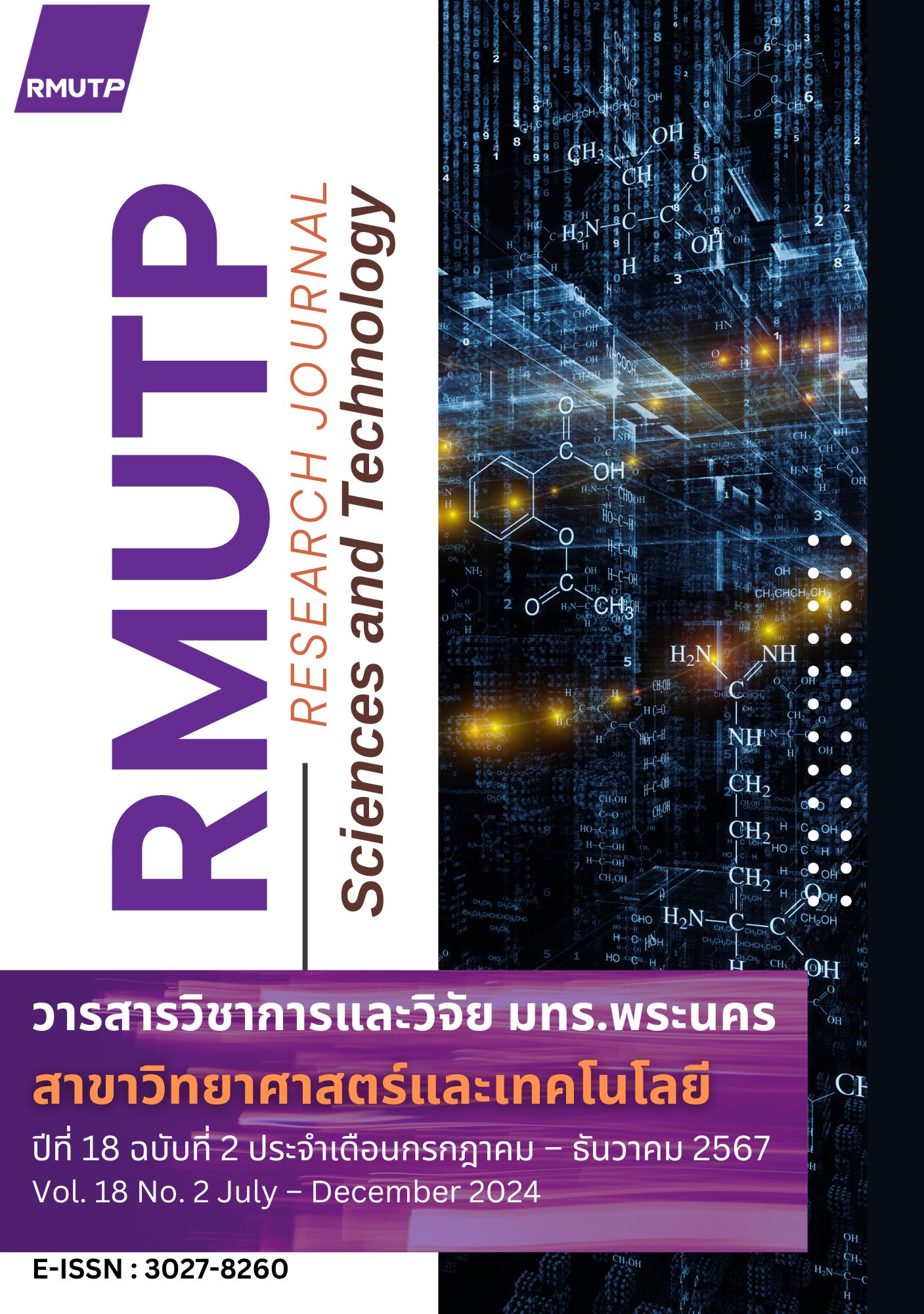การศึกษาอิทธิพลของแหวนต่อพฤติกรรมการถ่ายเทความร้อนสู่หม้อของเตาแก๊ส KB-5 โดยพลศาสตร์ของไหลเชิงคำนวณ
Main Article Content
บทคัดย่อ
งานวิจัยมีวัตถุประสงค์เพื่อศึกษาอิทธิพลของแหวนต่อพฤติกรรมการถ่ายเทความร้อนสู่หม้อของเตาแก๊ส KB-5 โดยพลศาสตร์ของไหลเชิงคำนวณ และการทดลอง ซึ่งแบบจำลองถูกสร้างขึ้นโดยโปรแกรม ANSYS 21 ในรูปแบบ 3 มิติ โดยศึกษาอิทธิพลของแหวนต่อพฤติกรรมการถ่ายเทความร้อนสู่หม้อ การถ่ายเทความร้อนสู่หม้อของเตาที่มีแหวนคือ Model B และ Model C เปรียบเทียบกับเตาแบบดั้งเดิมที่ไม่มีแหวนคือ Model A และทำการวิเคราะห์ผลฟลักซ์ความร้อนรวมจากการจำลองและประสิทธิภาพเชิงความร้อนจากการทดลอง จากการศึกษาพบว่าฟลักซ์ความร้อนรวมจากแบบจำลองและประสิทธิภาพเชิงความร้อนทดลองของเตาที่มีแหวนทั้งสองเตาดีกว่าเตาที่ไม่มีแหวน โดย ฟลักซ์ความร้อนรวมของ Model C มีค่าสูงสุดเท่ากับ 24.40 กิโลวัตต์ต่อตารางเมตร รองลงมาคือ Model B และ Model A มีฟลักซ์ความร้อนรวมเท่ากับ 21.42 และ 18.32 กิโลวัตต์ต่อตารางเมตร ตามลำดับ หรือ Model C และ Model B มีฟลักซ์ความร้อนรวมเพิ่มขึ้น 24.92 และ 14.47 เปอร์เซ็นต์ ตามลำดับ เมื่อเทียบกับ Model A และประสิทธิภาพเชิงความร้อนของ Model C มีค่าสูงสุดเท่ากับ 45.80 เปอร์เซ็นต์ รองลงมาคือ Model B และ Model A มีประสิทธิภาพเชิงความร้อนเท่ากับ 42.40 และ 39.15 เปอร์เซ็นต์ ตามลำดับ หรือ Model C และ Model B มีประสิทธิภาพเชิงความร้อนเพิ่มขึ้น 14.52 และ 7.67 เปอร์เซ็นต์ ตามลำดับ เมื่อเทียบกับ Model A ซึ่งแสดงว่าเตาที่มีแหวน (Model C) มีสมรรถนะในการถ่ายเทความร้อนสู่หม้อดีที่สุด
Article Details

อนุญาตภายใต้เงื่อนไข Creative Commons Attribution-NonCommercial-NoDerivatives 4.0 International License.
ลิขสิทธ์ ของมหาวิทยาลัยเทคโนโลยีราชมงคลพระนครเอกสารอ้างอิง
Energy Policy and Planning office (EPPO) Ministry of Energy. (2021). Energy statistics of Thailand 2021. [Online]. Available: http://www.eppo.go.th/images/Energy-Statistics/energyinformation/Energy_Statistics/00All.pdf
S. Jugjai and S. Sanitjai, “Parametric Studies of Thermal Efficiency in a Proposed Porous Padiant Recirculated Burner (PRRB): A Design Concept for the Future Burner,” International Energy Journal, vol. 18, no. 2, pp. 97-111, Dec. 1996.
U. Makmool, S. Jugjai and S. Tia, P. Vallikul and B. Fungtammasan, “Performance and analysis by particle image velocimetry (PIV) of cooker-top burners in Thailand,” Energy, vol. 32, no. 10, pp. 1986-1995, 2007.
N. Rungsimuntuchat, “Application of Porous Medium for Energy Saving in Gas Cooker,” M. Eng thesis, Department of Mechanical Engineering, King Mongkut’s University of Technology Thonburi, Bangkok, Thailand, 2011.
S. Sudarno, S. Soeparman, S. Wahydi and A.S. Widodo, “Effect of the EMBER Element in Increasing the Efficiency of Liquefied Petroleum Gas Stoves,” Journal of Applied Engineering Science, vol. 19(2021)2, pp. 375-382, 2021.
M.Y. Khan and A. Saxena, “Performance of LPG Cooking Stove Using Different Design Of Burner Heads,” International Journal of Engineering Research & Technology (IJERT), vol. 2, no.2, pp. 656-659, July. 2013.
A. Tamir, I. Elperin and S. Yotzer, “Performance Characteristics of a Gas Burner with a Swirling Central Flame,” Energy, vol. 14, no.7, pp. 373-382, 1989.
M. Wichangarm, A. Matthujak, T. Sriveerakul and S. Sucharitpwatskul, “Simulation of Flow Characteristics in an Energy-saving High-pressure gas Stove,” in Proceeding of 30th Conference of Mechanical Engineering Network of Thailand, Songkla, Thailand, 2016, Paper no. CST0027.
T. Punchapong, A. Matthujak, M. Wichangarm, T. Sriveerakul and S. Sucharitpwatskul, “Simulation of Flow Characteristics in a Gas-saving High-pressure gas Stove by Computational Fluid Dynamics,” in Proceeding of 31st Conference of Mechanical Engineering Network of Thailand, Nakhonnayok, Thailand, 2017, Paper no. CST09.
A. Matthujak, T. Chanakul, M. Wichangarm, T. Sriveerakul, B. Chanthamas, S. Sucharitpwatskul and S. Sucharitpwatskul, “A Study on Influence of Swirl Angle of Burner Port on Behavior of Heat Transfer to a Vessel of High-pressure Cooking Stove by Computational Fluid Dynamics” RMUTP Research Journal, Vol. 14, No. 1, January-June 2020, pp.70-81, 2020.
P. Chimchom, A. Matthujak, M. Wichangarm, T. Sriveerakul, and S. Sucharitpwatskul, “Simulation on Combustion Behavior of Gas-saving Burner S-10 by Computational Fluid Dynamics” RMUTP Research Journal, Vol. 14, No. 1, January-June 2020, pp.165-176, 2020.
M. Wichangarm, A. Matthujak, T. Sriveerakul, S. Sucharitpwatskul and S. Phongthanapanich, “Simulation Study of LPG Cooking Burner,” International Journal of Engineering & Technology, vol. 7, no3.7, pp. 142-144, 2018.
A. Matthujak, M. Wichangarm, T. Sriveerakul, S. Sucharitpwatskul and S. Phongthanapanich, “Numerical investigation on the influence of swirling flow to thermal efficiency enhancement of an LPG-energy saving burner,” Case Studies in Thermal Engineering, vol. 28 (2021), 101466, 2021.
M. Wichangarm, A. Matthujak, T. Sriveerakul, S. Sucharitpwatskul and S. Phongthanapanich, “Investigation on thermal efficiency of LPG cooking burner using computational fluid dynamics,” Energy, vol. 203, 15 July 2020, 117849, 2020.
P. Aroonjarattham, “The Parametric Studied of High Pressure Gas Burner Affect Thermal Efficiency,” Engineering Journal, vol. 20(3), pp. 33-48, 2016.
M. Wichangarm, A. Matthujak, T. Sriveerakul, S. Sucharitpwatskul and and S. Phongthanapanich, “A study on effect of swirling flow on behavior of heat transfer to vessel of high-pressure cooking stove by computational fluid dynamics,” in Proceeding of 33th Conference of Mechanical Engineering Network of Thailand, Udonthani, Thailand, 2019, Paper no. AEC-003.
ANSYS, Ansys Fluent Theory Guide. Canonsburg, Pennsylvania: ANSYS, Inc., 2013.
German standards and technical rules. 1997. p. 17. DIN EN 203-2: Gas-heated catering equipment.
D.G. Vlachos, L.D. Schmidt, and R. Aris, “Ignition and extinction of flames near surfaces: Combustion of H2 in air,” AIChE Journal, vol. 40, no.6, pp. 1055-1018, 1994.
S. Chander, and A. Ray, “An experimental and numerical study of stagnation point heat transfer for methane/air laminar flame impinging on a flat surface,” International Journal of Heat and Mass Transfer, 51(2008), pp. 3595-3607, 2008.


